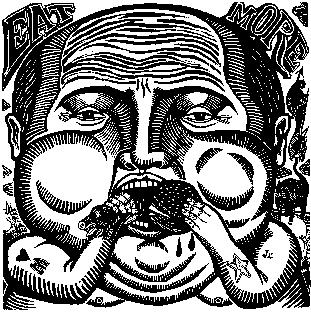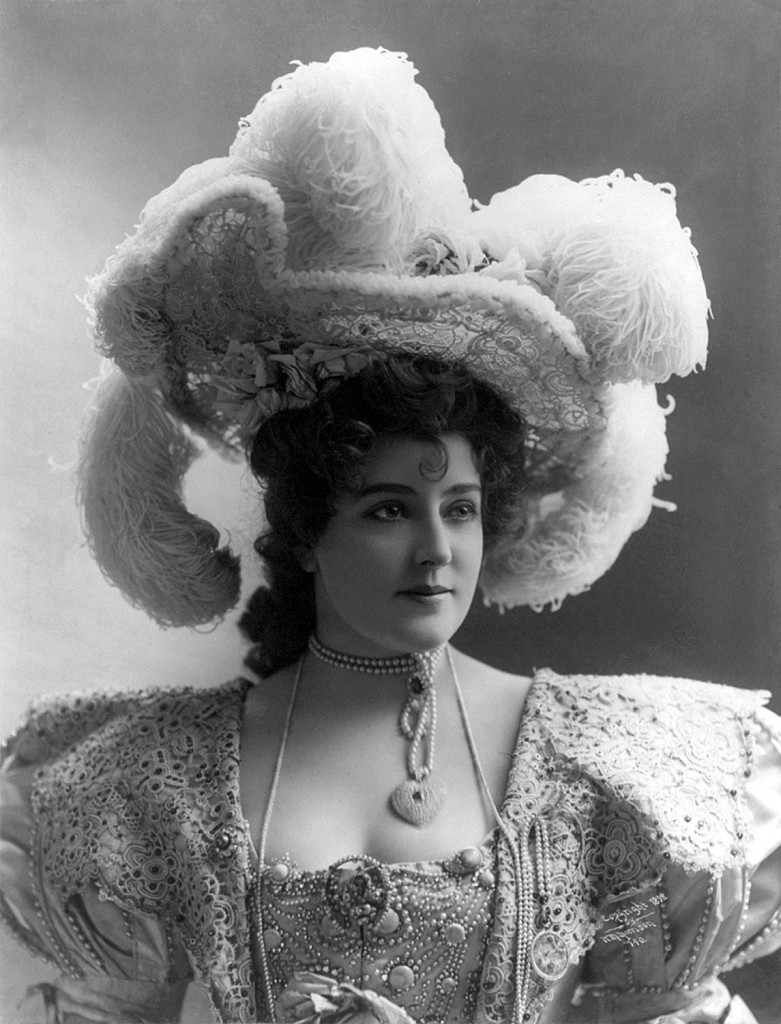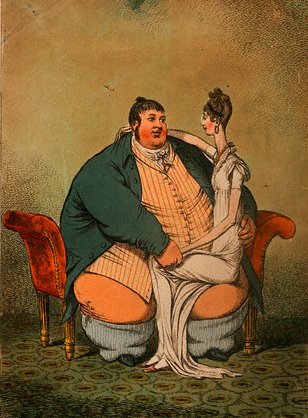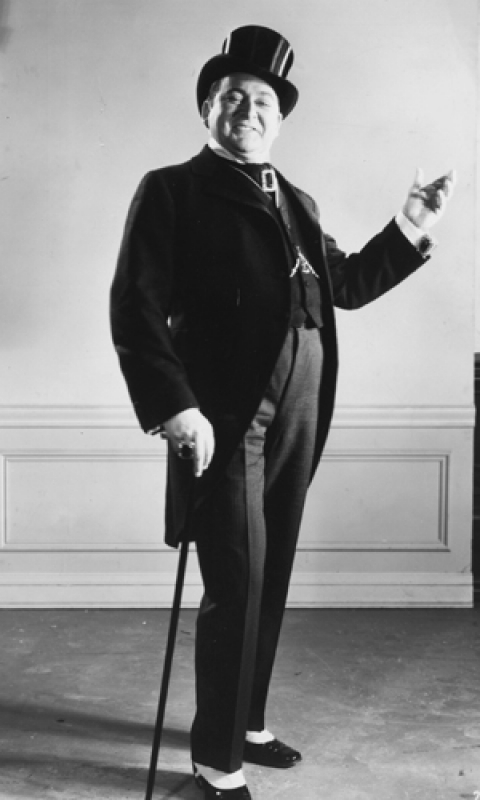“Researching one of the seven deadly sins, gluttony, although food implies a consistent research into the bodily (taboos). To Nietzsche, largely responsible for rehabilitating the body in later humanistic thought, sinning is not a basic state of humanity, but merely an ethically religious interpretation of physiological indisposition. Foucault, following Nietzsche, thought that the body, poisoned with food or values under the pressure of various regimes like eating habits and moral laws, creates obstacles.”…
Food was the basis of the first class system. Superior nourishment is the most primitive form of privilege. Socially differentiating cuisines, however, occurred relatively late and, until recently, were found only in some parts of the world. Originally, quantity mattered more than quality.The gigantic appetite has normally commanded prestige in almost every society, partly as a sign of prowess and partly, perhaps, as an indulgence accessible only to wealth. Gluttony may be a sin, but it has never been classed as a crime. On the contrary, it can be socially functional. Big appetites stimulate production and generate surplus – leftovers on which lesser eaters can feed. So long as the food supply is unthreatened, eating a lot is an act of heroism and justice, similar in effect to other acts of this kind, such as fighting off enemies and propitiating the gods…..
It was a big country populated with larger-than-life personalities. And big appetites. James Buchanan Brady ( 1856-1917). Better known as Diamond Jim. The fact remains that the young man who was born, fittingly enough, the son of a free lunch counter and saloon operator, whose first job was as a hotel bellboy, and who went on to legendary heights as a salesman of railroad equipment, and as the country’s number one eater, to even more legendary widths, left behind him an enduring name.
When aspersions were cast on the authenticity of his diamonds, Jim was inclined, casually, to scratch his name with them on the doubter’s window-pane. When similar skepticism was accorded his gustatory prowess, however, he did not even deign to acknowledge it. Brady, born in 1856, lived in the era of the fifteen course dinner, and no public dancing, as we know it today, was permitted. In a sense, there was nothing to do but eat. And it was thus an era made to order, a la carte, of course, for Diamond Jim.

- Gargantua. ”Much loathing of gluttony, then and now, often leads into a full-bore assault on the body itself, a general hatred for the unclean process of eating, digesting and voiding. As the repellent Saint John Chrysostom, author of Eight Homilies Against the Jews, put it, “the increase in luxury of eating is nothing but the increase in excrement”
“…The Old Testament laws on sin were reshaped in the Gospels under the influence of the recognition of some of the psychology of sin. Not so much sin as a single act, but rather mortal sin as a characteristic of humanity. The sinner, under the pressure of internal conflict (unfulfilled needs and desires) resolves their situation with anger, gluttony, greed, sloth, lust, envy or pride. In modern times these so-called deadly sins are recognized under more clinical names: neurosis, dependencies, personal crisis.”…
Comparisons with other great gourmets were simply preposterous. Years after he was gone, his eating feats were passed on by those who knew him. Years after he was gone, his eating feats were passed on by those who knew him. For breakfast he would have a full gallon of orange juice; actually he had several beakers of this at every meal, a fact which was later described as having prolonged his life. Then came, in rapid succession, hominy, eggs, corn bread,muffins, flapjacks, chops, fried potatoes, and a beefsteak.
This breakfast would hold him until about 11:30, at which time he would have his mid-morning snack, one which consisted of two or three dozen clams and oysters. An hour later he was ready for lunch. First, more oysters and clams, then two or three deviled crabs, next a brace of boiled lobsters, followed by a joint of beef, a salad, and several kinds of fruit pie.
…”Humans are the only beings not entirely determined by natural conditions (e.g. feeding), even though we live in a body of a certain gender, in a certain society etc. (not a ‘natural’ condition) etc. (the biological and social structure of an individual). Food, and with it, the maintenance of life are connected with the most intimate core of every human being. Gluttony has always been one of the more socially acceptable sins, with which the sinner replaces unfulfilled (mainly) emotional needs. Similar to anger, the subject of the first research, gluttony is among the most physiological sins (an emotional response to a certain deficit). Today, the self-destructive nature of gluttony is labelled as addiction, an illness opening up numerous discussions on the phenomena of clinical relationships to food such as obesity, bulimia, anorexia, or manic slimming. Food also offers a certain amount of bodily pleasure, often leading to a trauma/deficit of pleasure: the dissatisfaction with one’s image leads into chronic battles with weight, the imperatives of fashion, and consumerism, strategies of socialization etc. “….

- ”Gone (forever?) are the great, voracious gluttons of old–Falstaff (“that trunk of humours, that bolting-hutch of beastliness, that swollen parcel of dropsies, that huge bombard of sack”); Orson Welles (whose evening repast would consist of two steaks and a pint of scotch); Henry VIII; Robert Earl Hughes, who had to be buried in a piano case-sized coffin; Gargantua; Diamond Jim Brady, the American industrialist who would sit six inches away from the table and only stop eating when his gut reached the table edge.
During the afternnon
e another snack, again a platter heaped skyward with seafood, this time followed by several bottles of lemon soda. Then, records his awed biographer, Parker Morrell, after a couple hours, he would go down to dinner. Wilson Mizner once observed, ”Jim likes his oysters sprinkled with clams and his sirloin steaks smothered in veal cutlets”.
First of course, came the napkin. Jim wore a napkin around his neck, but this was not due to etiquette but rather a question of topography. A napkin on his knee as inadequate as a placemat under an elephant. Diamond Jim’s stomach started at his neck and sweeled out in majestic proportions, gaining power and curve as it proceeded southward. Therefore the only place where the napkin would have done him any good was around his neck. And there he wore it. Like a bookmark in a tome of chins.
To begin with, at dinner, came oysters. Diamond Jim would often eat as many as three dozen Lynn-haven oysters, each measuring six inches from tip to tail. The would follow half a dozen crabs, claws and all. After the crabs came a brief pause for green turtle soup, at least two portions, and then appeared a deluge of lobsters; six or seven. Next came two portions of terrapin, two whole canvas back ducks and, at long last, a steak and vegetables. Finally of course came desssert, which was supplemented by cakes and pastry.
The meal would conclude with Jim ordering a two pound box of candy which he would pass around among his guests. But, if a guest actually took any, Jim made a habit of ordering another two-pound box for himself.They made the food set better de declared, and they evidently made the theatre set better, too. A devoted first nighter all his life, Brady was never known to arrive at the theatre without his accompanying box of candy. ”Shaw was more tolerable with bon-bons and Ibsen was best with glace-fruit, he explained.
After the theatre, naturally, came supper. Not a bird and a bottle, but several birds and several bottles, though for Jim there was never any hard liquor. Once, however, concluding a hard days eating at Harry Hill’s, the famous sporting house, he was challenged to a drinking duel b the pugilist John L. Sullivan. Over a two hour period, Jim calmly drank some fifteen enormous steins of root beer without visible disaffect, therby garnering the lifelong admiration of the fighter who had been drinking Pilsener and thought Brady had been, too.

His favorite restaurant in the city was Charles Rector's, an exclusive establishment on Broadway. The owner described Diamond Jim as his "best 25 customers."
All in all, covering a sixteen-hour span, Diamond Jim consumed a truly incredible amount of edibles. ”You must be very proud of your appetite, Mr. Brady, ” a grande dame once said icily , as Brady heaved himself up from her elegant table. ”And how do you ever know when your appetite is satiated?” ”Why, Ma’am, I’ll tell you,” Brady replied with pristine simplicity, ”whenever i sit down to a meal, I always make it a point to leave just four inches between my stummick and the edge of the table. And then, when I can feel ‘em rubbin’ together pretty hard, I know I’ve had enough”.
“…Returning to desire, according to Lacan, and the meaning it supposedly has for bodily pleasure, we see how it continues to work in a negative way. In its search for the so-called surplus pleasure it has to remain unfulfilled, which is why it is always followed by the “more”, depicted in a twisted form by the relentless “stuffing of mouths”. The unfulfilled/prohibited desire is the negative foundation of our lives, bound to the field of reality, upon which the imaginary and symbolic are also built (the negativity of the law of symbolic order: the suspension of pleasure). In a twisted sense, under the constant pressure of drive, we can actually devour food in our search for partial satisfaction (no food will ever satisfy the oral drive, related to the lacking object), in order to gain, at least, so-called oral pleasure, demarcating the identity of the subject one way or the other in its “sinful” excess. This is because every human being is defined by a double build in which it is both a being of need and a being of desire….”

At a famous eating bout at Bustanoby's in Saratoga, however, the scales were tipped in the other direction when before the contest, Lillian disappeared. ''I'll never forget that night,'' Bustanoby later said in an interview. ''She slipped out to the ladies room and came out with a heavy bundle under her arm wrapped up in a tablecloth. 'Keep this for me,' she said, 'but don't look.' '' That night Lillian won fair 'n' square; what was in the tablecloth, of course, was her corset.
Most of his eating was done out. ”Between Mr. Brady and the expense account, it was a case of love at first sight,” recorded biographer Parker Morell. And Jim, curiously, never married. For ten years he had a liason with Edna McCauley, a handsome blonde who had been a department store salesgirl until Diamond Jim picked her up, only to have her in the end, marry his best friend Jesse Lewisohn. Ironically, before that time Lewisohn had been the lover of Jim’s froend, Lillian Russell, who managed to marry four other men in between lovers but was nonetheless fated to go down in history gustatorily, if not amatorially, with Diamond Jim.
For when big Lil was turning down diamonds from legions of swains, it was Diamond Jim who won her heart by teaching her new ways to eat corn on the cob. Lillian liked her dinner and, by that time perhaps the two foremost celebrities of the day, the pair would hold rendez-vous where the chief purpose of the assignation seemed to be to see which one could assassinate the most vittles. Brady almost always won, but ”for a woman. Nell done damn well.”

- ”Francis Hayman depicts Falstaff in this oil. Falstaff is one of Shakespeare’s most beloved characters, a rogue who frolics with the young Prince Hal. Falstaff’s antics makes audiences laugh as he rationalizes his way through robbery and cowardice. Despite his delightfully flawed behavior, audiences love the Falstaff and rue the day Prince Hal must leave him behind for the responsibilities of kingship in Henry V. ”
”Kamp quotes John Mariani’s “America Eats Out” for the standard Brady menu, and I’ll do the same–I apologize for the length of the quote, but I can only attribute it to the length of Brady’s supposed daily menu:
Brady is described as having routinely begun his day “with a hefty breakfast of eggs, breads, muffins, grits, pancakes, steaks, chops, fried potatoes, and pitchers of orange juice. He’d stave off mid-morning hunger by downing two or three dozen clams or oysters, then repair to Delmonico’s or Rector’s for a lunch that consisted of more oysters and clams, lobsters, crabs, a joint of beef, pie, and more orange juice.”

And Brady was, as always, a good sport. Once after an enormous eating repast at manhattan Beach, he turned beaming to Lillian, as, happy after a Gargantuan dinner, they were watching the fireworks. ''God, Nell,'' said Diamond Jim, ''ain't it grand?''
The double standard of the day was, for Diamond Jim Brady, no more of a problem than the women who could not, for better or worse, lure him from the pleasures of the table. There was, for example, the little manner of Stanford White’s Jack Horner pie dinner, at which Jim was gustatory guest of honor, and also at which girl’s danced, it was alleged ”in the altogether”. At this dinner a mammoth pie was placed in the center of the table and at a given signal, each of the gentlemen present took hold of a long satin ribbon and tugged. Promptly, the side of the pie fell apart, and a young lady clad only in a satin arm band danced down the table to where Jim sat. All the other men cried out until altogether eleven other young ladies joined the party. Only Diamond Jim, unperturbed, went on with the business at hand.
Diamond Jim was no mean partygiver himself. In honor of his recehorse, Gold Heels, he once entertained fifty friends at a dinner on the roof of the Hoffman House. Between four o’clock on a Sunday afternoon and nine o’clock the following morning, more than five hundred bottles of champagne were consumed, not to mention innumerable beef steaks and assorted delicacies. The part cost Jim more than $100,000, including $60,000 worth of baubles for the guests; diamond brooches for the ladies and diamond studded watches for the men.
”Diamond Jim spared no expense when it game to getting cool stuff even if he couldn’t eat it. He had a dozen gold plated bicycles manufactured for his girlfriend and himself. His honey was actress and singer Lillian Russell – her favorite bike had handlebars covered with mother of pearl and spokes garnished with rubies and sapphires. His own collection of jewelry was conservatively estimated to be worth two million dollars back then. No, nothing was too good for Jim and his gal.”
For Jim, a restauranteur would go, literally, to any lengths. There was, for instance, the case of the Fillet of Sole Marguery, a la Diamond Jim. Diamond Jim had returned from Paris and wanted the meal, but no one in the States could duplicate the sauce. George Rector’s father sent him to France to serve as apprentice cook before being permitted to ”get the hang of the sauce”, and he finally produced a combination voted perfect by a jury of seven master chefs. He was met at the port on his return by his apprehensive father and a bellowing Diamond Jim.”Have you got the sauce?” Brady roared, as the gangplank lowered. ”I got it” , young Rector screeched in reply and that night at a private dinner he made good on his claim.
” George’,, said Diamond Jim, folding his napkin over what was perhaps the widest waistcoat in the western hemisphere. ”That sole was marvellous. I’ve had nine helpings, and even right now, if you poured some of the sauce over a Turkish towel, I believe I could eat all of it.” ”He was,” said George Rector, ”the greatest gourmet of his time”.
In the end, of course, the strain told. At fifty-six, Jim was taken to John Hopkins where it was discovered, under fluorscope, that his stomach was six times as large as a normal person’s. When told, that with care and constant diet, he could live for ten more years, he stoutly refused. ”Who wants to live ten years” , he said, ” if he has to do all them things? I’m gonna go on eatin’ what I please as long as I can keep my food down. The when I cash my chips it’ll be because my number’s up anyway.” Five years later, on April 16, 1917, at the Shelburne Hotel in Atlantic City his number did come up.
“Such triumphs of heroic eating were not considered selfish. The rich man’s table is part of the machinery of wealth distribution. His demand attracts supply. His waste feeds the poor. Food- sharing is a fundamental form of gift exchange, cement of societies; the chains of food distribution are social shackles. They create relationships of dependence, suppress revolutions and keep client classes in their place. The fruit whose “mortal taste” was the source of all our woe did, after all, grow on the tree of knowledge. Eating, sin, and guilt have always constituted a powerful holy trinity connected to the broader relationship of pleasure and morality. Throughout Milton’s Paradise Lost and Paradise Regained, Milton plays with the epistemological connotation of taste ;Samson Agonistes, whose blind hero declares, “The way to know were not to see but taste” . At the time Milton was writing, however, taste was philosophically connected not only to knowledge and pleasure, but to morality as well.”
“…Food as a scenic element works distinctively through the olfactory senses, affecting the one sense that is usually not stimulated in theatre and thereby opening up new possibilities of identification to the viewer. These can be connected to disgust instead of to feelings of (aesthetic) pleasure. Smells are still traditionally not part of the hygiene-order-beauty triad, our civilization’s foundations. Smell, being in contradiction to order and hygiene, evades beauty. That what is beautiful does not smell is a form with which the discourse of Kantian aesthetics (the disinterested judgment of taste enabled by the disembodied point of view) expresses the sublimation of all that in one way or another connects with excrement. The sense of smell is excluded from aesthetics as that which speaks about the alchemy of the circulation of matter. Edibility cannot be part of “good taste”. We may say about a dish that it is beautiful, which does not yet suggest its edibility – yet it is enough to ensure that food is not entirely excluded from the reaches of beauty. But smell does not go that far: it can be good, pleasant, delicious, but it can’t be beautiful. In the case of the performance discussed, the simultaneity of sensing is the gauge of the successful demolition of the aesthetic distance of theatre, bounded by modernist aesthetics, enabling the viewer’s irrevocable tie-in with the real theatrical action.”
ADDENDUM. “But while desires are supposedly sustained by the inability of satisfaction or the unattainability of the desired object (central lack) in accordance with the pleasure principles, pulsion is always satisfied, regardless of the will and pleasure of the subject (satisfaction may soon take apart the economy of pleasure; besides, according to Lacan, the reality of the body in pleasure/pain is also the border of any discourse): “Whenever you feed the mouth – the one opening in the registry of pulsion – they’re not satisfied by food, but by that which we call oral pleasure”.
Even though the so-called oral phase implies “an attitude of wanting to ‘devour it all’ and thereby satisfy all needs“, the child’s turn into the inter-subjective symbolic economy is key: due to its dependency, the satisfaction of its needs is defined by the demand of the Other (primarily mother, later authorities of tradition, convention, law: the act of interdiction). The child eats and “cleans the plate” in order to demonstrate obedience and the ability not to stain itself while eating etc. “In short, we satisfy our needs in order to earn our place in the societal order.” (A picturesque rendition of this situation can be found in the caricaturized exaggeration in Zorc’s piece Golden Birdy.)”

















 COMMENTS
COMMENTS




There were in the town where I was born a group of 4 or 5 men who would gather to drink/eat
Gargantùan style, extremely fat and potbellied excepting 1 who was slender, even ate as much; they were middle class, even lower middle class 2 of them; but I do not remember throughout my life any truly rich person with those habits, they usually are very ignorant people, as it was Diamond Jim, I guess.
I don,t know if Diamond Jim was ignorant or not. The whole notion of eating and our relation to food appears very complex. This is the second time I’ve had a peek at this issue and each time there is only fragments of its psycho-social relationship that is revealed. Thanks for reading